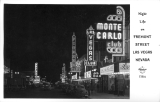The Pioneer Club (western corner)
This was home to the Isis Theater in the early days of Las Vegas. There were a couple of movie theaters in those early years. The Majestic and the Airdome were also on Fremont Street. The Airdome was an open air theater with some canvas walls, a screen and chairs. In the summertime, they were the one theater to show movies outside, and as there was no air conditioning, they did good business on a summer's night.
The Isis gave way in the 1920s to the Las Vegas Hotel and Cafe and then became the Smokehouse Restaurant. The Smokehouse had a tough go of it at that time. The Union Pacific had pulled out of Las Vegas during the strike of 1922. While trains still came through hauling passengers and freight, the machine and welding shops were closed. "Live was pretty tough in those days", remembers Ed Von Tobel, Jr.
As the population dwindled down to only the most heartiest who continued to believe in the town, the Smokehouse closed. The Bank Club opened very briefly and then in 1930 reopened as the original Las Vegas Club. The Las Vegas Club received one of the first gaming licenses offered in 1931.
The Las Vegas Club would remain at this location untlil the late 1940s. It was then that owner Kell Houssels, Sr moved the Club across the street to its present location.
In 1947, Housels took on a partner, a colorful Texas gambler by the name of Benny Binion. When Houssels moved the Las Vegas Club across the street, Benny Binion opened The Westerner with its moving neon sign and mural opened in its place.
Fremont Street day mid 1940s
The Pioneer Club (eastern corner):
Jake Beckley came to Las Vegas with Ed Von Tobel, Sr. They were both young men looking for another chance. They found it here in Downtown Las Vegas. Together they would start Von Tobel Lumber. It was originally on Main Street, south of the train depot. But in a small town just beginning to grow, Von Tobel Lumber was considered too far out of town and was one of almost ten Lumber Yards. Times were tough.
Jake Beckley decided that perhaps what people needed more than Lumber and Hardware was clothes. His brother Will was just the guy for the job. The Beckley brothers bought a building on the south side of Fremont Street on the corner of 1st Street. There they opened Beckley's Mens Wear. The three-story building featured the store on the ground floor and offices upstairs. One of the rooms on the second floor was used as a social gathering place by the Mesquite Club and other women's auxiliaries. Jake, shortly afterward, amicably ended his partnership with Von Tobel.
Beckley's Mens Wear soon branched out to other fashions as well. The business did well, surviving the Depression. In the mid-1940s, the store was closed. The building was leased to Tudor Scherer and his partners, Farmer Page, ChuckAddison and Bill Curland. The Beckley's kept the land. Scherer and his partners opened the Pioneer Club in 1942.
In a smart move in 1951, the Chamber of Commerce approached Young Electric Sign Company about designing and building a neon cowboy for the Pioneer Club. Vegas Vic was to become the icon of Fremont Street. Myths over the years having various designers being responsible for Vic and many others purported to be the model. Vic was designed by one of Yesco's Salt Lake City designers, Patrick Denner. Vic was 75 feet tall, had one moveable arm with a glowing cigarette in one hand and the other arm moved back and forth. He had a voice box that proclaimed "Howdy Podner" every 15 minutes. Vic stopped talking in 1966 when Lee Marvin and Woody Strode, tired after a day of working on location in the Valley of Fire for the film "The Professionals", were kept awake by Vic's friendly greeting. Taking a couple of bows and arrows from the prop department, one night they commenced shooting at Vic from their hotel rooms across the street at the Mint Hotel. City Fathers decided that perhaps it was best if Vic stopped talking. Vic has an older brother of sorts, Wendover Will located fittingly enough in Wendover, Nevada. He, too, was designed by Patrick Denner.
The Pioneer Club had various owners over the years including Circus Circus executives, one of which was the grandson of Will Beckley. The Pioneer finally closed in 1995 and became the large souvenir shop it is today. It is now owned by Schiff Enterprises.
The signage over the years has changed very little. The rooftop sign that faces east towards the Golden Nugget is endangered. Leroy's Sports Book and Mike's Liquor which used to be on First Street next to the Pioneer have recently been demolished. Across Fremont Street, there once was a roof-top sign on the old Las Vegas Pharmacy building. This colorful neon sign had a neon Vegas Vic face with signage proclaiming There it is! The Famous Pioneer Club and an arrow pointing across the street towards the Pioneer Club. That sign was destroyed in the late 1950s when the Pharmacy Building was demolished to make room for the Silver Palace.
Vegas Vic still presides over Fremont Street. He went through a few years of disrepair. But when the Fremont Street Experience was erected, Vic's famous ten galloon hat was reduced and his waving arm became immobile so that he would fit under the Experience's canopy. Today he is one of the few remaining iconic pieces of neon from Fremont Street's days as Glitter Gulch.
New Pioneer Club












